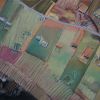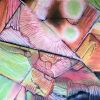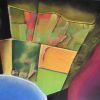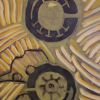Northwest Highlands and Hebrides Series
The landscape artist must meet the challenge, on the one hand, of applying reason to reading and deconstructing the landscape in order to accurately, objectively and rationally bear witness to the narratives encoded there and to seek ways of explaining the processes involved in these narratives.
On the other, landscapes possess a depth of meaning, an intentionality and essence, which goes beyond their physical and sensory properties. Traditionally it is to literature and the arts that people turn to express this depth of meaning and the spirit of landscape.
So the second challenge to the landscape artist is to accept this responsibility to produce work that is a conduit for the emotions, the imagination and the spirit, whilst remaining true to the reality of the landscape and avoiding the pitfalls of the overly romantic and picturesque associated with some art of the past.
These works address landscape as a cultural construct and the way that cultural discourse and meaning is captured and preserved in landscape pattern. By engaging with pattern they hope to find a way to meet, at least in part, the challenges articulated here.
The crofting landscapes of Sutherland and the Hebrides are resonant with landscape pattern. Some pattern reflects underlying structures in the natural landscape, some has evolved with indigenous culture and some is imposed cultural pattern. All of these manifestations of pattern have an inherent visual appeal but also embody landscape memory and preserve an often poignant narrative.
The Landscape of the Northwest and the Islands
Some of these works have sought to map landscape pattern in order to embrace the true spatial reality of landscape without the constraints of traditional perspective and the normal expectations of landscape painting. However, here the conventions of topographic mapping are stripped away to create art works that while informed by and rooted in the reality of the landscape nevertheless lean towards abstraction.
The landscape artist must meet the challenge, on the one hand, of applying reason to reading and deconstructing the landscape in order to accurately, objectively and rationally bear witness to the narratives encoded there and to seek ways of explaining the processes involved in these narratives.
On the other, landscapes possess a depth of meaning, an intentionality and essence, which goes beyond their physical and sensory properties. Traditionally it is to literature and the arts that people turn to express this depth of meaning and the spirit of landscape.
So the second challenge to the landscape artist is to accept this responsibility to produce work that is a conduit for the emotions, the imagination and the spirit, whilst remaining true to the reality of the landscape and avoiding the pitfalls of the overly romantic and picturesque associated with some art of the past.
These works address landscape as a cultural construct and the way that cultural discourse and meaning is captured and preserved in landscape pattern. By engaging with pattern they hope to find a way to meet, at least in part, the challenges articulated here.
The crofting landscapes of Sutherland and the Hebrides are resonant with landscape pattern. Some pattern reflects underlying structures in the natural landscape, some has evolved with indigenous culture and some is imposed cultural pattern. All of these manifestations of pattern have an inherent visual appeal but also embody landscape memory and preserve an often poignant narrative.
The Landscape of the Northwest and the Islands
Some of these works have sought to map landscape pattern in order to embrace the true spatial reality of landscape without the constraints of traditional perspective and the normal expectations of landscape painting. However, here the conventions of topographic mapping are stripped away to create art works that while informed by and rooted in the reality of the landscape nevertheless lean towards abstraction.
Northwest Highlands and Hebrides Series

Callanish,

Sequent Occupance

Marks and Traces I

Marks and Traces II

Marks and Traces VI, Sheigra

Edgelands: Achlyness,

Edgelands: North Shore II

Edgelands: North Shore

Highlands&Islands-09

Highlands&Islands-10

Marks and Traces V

Marks and Traces VI

Marks and Traces VII,

Marks and Traces VIIa

Marks and Traces VIIb

Feanagan (Lazy Beds) I
Brilliant Space I – III,

Brilliant Space I

Brilliant Space II

Brilliant Space III,

Bragar II

Bragar Township, Isle of Lewis

Landscape Grid I

Landscape Grid II (SOLD)

Landscape Grid III, Rhiconich

Inchard I

Inchard II

